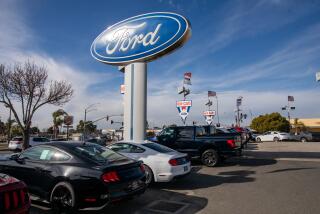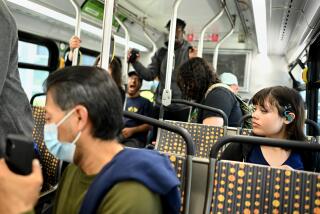One-car family? That’s so 1959
- Share via
A car in every garage has somehow become four or five in many driveways, a reflection of growing wealth in the U.S., the evolution of status and the needs of children to get around.
Buying the cars is one thing, but keeping license plates and insurance up to date, monitoring safety equipment and performing routine maintenance on a family fleet takes a remarkable amount of time.
A close friend of mine, David, was complaining over dinner recently about his fleet of four vehicles, saying that the minivan was down with a bum transmission and the Toyota’s engine bearings had been fried when his son forgot to check the oil. His own Subaru had differential problems and his daughter’s car had gotten banged up in a fender bender. He spent a day doing amateur body work in the garage.
Of course, the fleet manager of most traditional families is the dad or the man of the house, even though most modern men lost their mechanical skills decades ago. Anecdotally, it seems many women still seem to expect the man to take care of the family cars. A lots of guys I know barely know how to check the oil and generally don’t bother.
How do you manage to keep up four cars, I wondered? “It’s a living hell,” my friend said.
Well, maybe not quite that bad, but it’s definitely a load of mundane tasks that is becoming more common than you’d think.
More than 21 million households in the nation have more than two cars, according to a U.S. Census Bureau 2005 survey. Twenty-five percent of families that own their own home have more than two cars.
Almost 2 million families have five or more cars, which seems almost incomprehensible to anybody who grew up in a working-class household in the middle of the last century. Then, one car per family was the rule.
But that was then. This is an age of new affluence. Even for poor families, a priority is buying a car and getting off the bus.
Gale Dowell lives in Rancho Cucamonga with her husband and two boys. They have a van, two cars, four motorcycles and a fleet of seven trucks for an oil business. The parents are eyeing a new pickup truck for one of their sons. “To me, it is not a big deal,” Dowell said. “I grew up with six cars in my family.”
I would guess that the gasoline bill alone for a family with five cars must run at least $700 a month. But if you can afford the cars and the insurance, the gas is probably no big deal.
The effect of more cars on the road is significant on a societal scale, increasing traffic in established neighborhoods that once had adequate surface roads. It obviously affects air quality in Southern California, not to mention helping keep the U.S. as the world’s leading producer of greenhouse gases.
Caltrans projects a 20% increase this decade in the total number of vehicle miles traveled in the state. Over the next decade, more than 5 million extra vehicles will be added to the state’s total, driven by about 5 million more people. The formula is about one vehicle for one person as far as the eye can see.
The insurance industry has obviously noticed the trend. At Allstate, 60% of the policies cover more than one vehicle, said company spokesman Pete Moraga. When you insure more than one vehicle on the same policy, you get a break on the premiums. But the discount amounts to only 12% to 16% per car, he said.
For a lot of families, a car for each person is not so much a luxury as a necessity. With parents working, children have difficulty getting to music, art or sports activities, not to mention jobs. But not every household with a big fleet of vehicles is responding to the needs of children. Increasingly, families have vehicles dedicated to special tasks.
“You have a vehicle to commute in, a vehicle to pick up people at the airport and one to take up to the wine country on weekends,” said James Bell, publisher of the IntelliChoice automotive information guide. “It is a wealth issue and a status issue.”
Indeed, there are more autos than licensed drivers in the U.S., so we have moved beyond the car solely as tool of transportation, Bell said. Still, Bell laments the amount of time it takes to keep up his three-car household, even though he never ventures very deep into the greasy recesses of his cars.
“You pop the hood on cars today and you can’t even see the engine,” Bell said. “I struggle to make sure the registration is up to date.”
I won’t belabor the obvious, except to say that all primary driver in a household, including teenagers, ought to keep track of their own cars’ needs, including routine maintenance, checking tires for proper air pressure and making sure the insurance and registration are current. A trusted mechanic to maintain the family fleet is a necessity now too.
Every owner’s manual contains a maintenance log, and it should be kept current. There are computer programs and hand-held tools that can help, although gadgets can become part of another headache. A small notebook in the glove compartment with maintenance, registration and insurance information is a good starting point.
*







